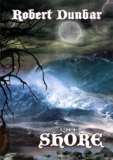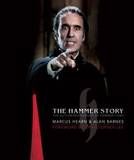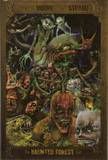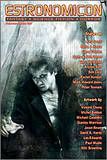Edgewise / Graham Masterton
 Leisure / May 2007
Leisure / May 2007
Reviewed by: Derek Clendening
The only thing worse than an unstoppable killer gunning for you is one you can’t see or hear. Such is the challenge facing the protagonist of Graham Masterton’s new Leisure title Edgewise, which dares to ask what lengths a parent would go to in order to save their children.
The novel’s basic premise is akin to Gord Rollo’s Jigsaw: big goods at a big price. When Lily Blake’s children are kidnapped, she is forced to make a tough decision. The police and FBI are useless so she decides to take a less conventional approach; she engages the services of a Sioux spirit called the Wendigo. As in all good games of horror-style Let’s Make A Deal, there’s a catch: the Wendigo can kill as swiftly as it can rescue. As the body count piles up, Lily is faced with more decisions and the dilemma of not being able to make her payment to the malevolent Wendigo that wants its pound of flesh.
The overall plot isn’t complex, but its narrative and crisp writing help Edgewise start fast and move swiftly. It exemplifies the harder punch that reality delivers, sweetened with a dose of the supernatural. Masterton uses the child abduction plot, reminiscent here of Whitley Strieber’s Billy, to force the reader to consider what they might do in the same situation. Yet Edgewise isn’t just about getting the kids back. Lily’s inability to pay for the Wendigo’s services places her in another realistic situation - desperately needing something she can’t pay for. This is another common human dilemma, and its incorporation here into the story proves that Masterton understands the horrors of the everyday realities of his readers.
Many horror plots rely on consequence to inspire fear. Masterton executes his plot well enough, but fails to put an ultimately satisfying spin on this relatively common concept. A Sioux spirit is different, but it’s still a run-of-the-mill spirit when stripped down. Masterton admirably tries to make up for this shortcoming by amping up the reader’s personal investment in the story. The problem here boils down to predictability. It’s not surprising that Lily gets her kids back, that she can’t pay her debt to the Wendigo, or that the spirit is particularly unforgiving. These contrivances are what avid horror readers have come to expect, yet some may find this a serious drawback. While better than employing the trendier vampire to rescue the kids, Edgewise still doesn’t leave the reader guessing.
Overall average when compared to Masterton’s more notable titles, Edgewise makes for a decent consumption of words that will leave readers with a few conventional chills.
Purchase Graham Masterton’s Edgewise.
The Rising: Selected Scenes from the End of the World / Brian Keene
 Delirium Books / December 2007
Delirium Books / December 2007
Reviewed by: Jeff Burk
Brian Keene is back with his third short story collection, The Rising: Selected Scenes from the End of the World. This time each of the stories explores an aspect of his dual-novel epic The Rising and City of the Dead. The book is composed of thirty-two short stories, each about six to eight pages. Beginning with the first zombie to rise and concluding with the end of the world, Keene provides short vignettes exploring the devastation in every corner of the planet. Cannibalism, serial killers, cults, crazed-soldiers, and, of course, zombies take center stage in each Grand Guignol-style tale.
In the last few stories, which take place after the events of City of the Dead, is where the book really shines, as the zombiism spreads to insect and plant life. The reader even gets a glimpse of the final destruction of Earth, as walking trees, swarms of ticks, and fire monsters move the book away from zombies and into the realm of the surreal.
Primarily known as a novel writer, short fiction has never been Keene's strength; yet these stories rank amongst his best works. Even with just a scant few pages, Keene is able to create moving characters and thrilling scenes. At points, the stories border on becoming monotonous, with looping plots of survivors hiding, something appropriately freaky happening, and the survivors dying. Repetition aside, there are more than enough surprises to keep readers engrossed through the last page.
If the names Troll, Worm, and Ob mean nothing to you, this book is not for you. But if you cannot get enough of Brian Keene's zombie universe, this is a wonderful companion piece to his two novels. Reading like a love-letter to his hardcore fans, The Rising: Selected Scenes from the End of the World is sure to delight those starving for a few more morsels of Keene's violent and bloody zombie mythos.
Pre-Order Brian Keene's The Rising: Selected Scenes from the End of the World
The Shore / Robert Dunbar
 Delirium Books / August 2007
Delirium Books / August 2007
Reviewed by: Shannon Riley
With his latest novel, The Shore, dark suspense master Robert Dunbar transports us from the sweltering New Jersey Pine Barrens, setting of his horror classic, The Pines, to the frigid oceanfront village of Edgeharbor, a dying tourist town caught in the grip of terror. A series of brutal unsolved murders bring a mysterious stranger into town in search of a boy who may be a monster or whose kind may be the hope of the future.
As a devastating storm breaks its wrath upon this isolated community, the elements themselves become an opponent as the stranger and a lone policewoman struggle to find a hostage girl who may well become the next victim.
Dunbar, a noted authority on folklore and legend, creates an intense and all too believable canvas on which to paint this tale of mounting terror and desperation. Here nothing is what it seems, and as revelations link the evil taking hold of Edgeharbor to murders from the past, the chilling connection to the Pine Barrens’ murders becomes apparent. While not a sequel in the truest sense of the word, The Shore enriches the story introduced in Dunbar’s previous novel, and sheds new light on the centuries old legend of the infamous Jersey Devil.
Impeccably crafted, with precise and elegant prose, meticulous attention to detail and pacing, this intense and wholly original novel is one of the best to come out of the horror genre in years. It left me breathless.
The Shore sets a new genre standard. This is horror at its best.
Purchase Robert Dunbar's The Shore.
The Hammer Story / Marcus Hearn & Alan Barnes
 Titan Books / September 2007
Titan Books / September 2007
Reviewed by: Blu Gilliand
In 1934, Hammer Productions Limited, a new filmmaking venture headed by entrepreneur/vaudeville veteran William “Will Hammer” Hinds, began production on its first film, The Public Life of Henry the Ninth. Beginning with this modest 61-minute comedy, the studio embarked on an eclectic slate of short films, thrillers and whodunits before hitting its stride with The Quatermass Xperiment, a science fiction/horror hybrid that firmly established the quality and atmosphere Hammer would provide film fans for years to come.
In The Hammer Story, a handsomely-produced oversize hardcover from Titan Books, Marcus Hearn and Alan Barnes faithfully document the humble origins of the famous studio in a couple of short, detailed chapters before diving headlong into the films themselves. The book leans heavily on Hammer’s bread-and-butter horror pictures, including the Quatermass movies and the various incarnations of Frankenstein and Dracula, but doesn’t skimp a bit on Hammer’s forays into genres as diverse as comedy, prehistoric adventure, and science fiction.
Dozens of films produced under the Hammer banner get comprehensive two-page spreads packed with production photos, publicity stills, posters and playbills, as well as in-depth, behind-the-scenes examinations of how the studio got the movies made. Wherever possible, the authors include anecdotes from key members of the cast and crew that range from the mundane to the fascinating. Many crucial figures in Hammer history, such as director Terence Fisher and actors Peter Cushing and Christopher Lee, have sections devoted exclusively to their contributions.
Where The Hammer Story truly succeeds (aside from the spectacular collection of photos and artwork) is in tone. This is no dry critical examination. The authors skillfully walk a fine line, treating the subject matter with reverence and respect without devolving into hero worship. The result is an information-packed book that is a true joy to read.
Purchase The Hammer Story by Marcus Hearn and Alan Barnes.
Mr. Hands / Gary Braunbeck
 Leisure / July 2007
Leisure / July 2007
Reviewed by: Derek Clendening
If you’ve ever picked up a book that commanded your attention and refused to be put down, Gary Braunbeck’s Mr. Hands will take you to familiar territory. Mr. Hands was published by Leisure books this past summer and is a compulsively readable return to Cedar Hill, the fictional setting of past Braunbeck works such as Keepers and In Silent Graves.
Braunbeck’s latest starts as so many good yarns do: with three guys sitting around in a bar, prepped for one hell of a story. He uses the oral storytelling tradition as a platform for the horror of Mr. Hands, a unique narrative structure in today’s mass market horror. Braunbeck constructs a non-formulaic plot more complex than linear storytelling, but without being too complicated to detract from its escapist enjoyment. The point of view volleys between first and third person to catch up with the desperate, on-the-run narrator. The cast of characters are all unique, believable creations. Even the bar patrons, stock characters in the hands of a lesser writer, are given a refreshing twist.
The major strength in Mr. Hands is Braunbeck’s powerful, crisp writing. Excellent prose is no throwback, and Braunbeck matches up with such greats as Richard Laymon, Jack Ketchum and Ray Garton. The difference between Braunbeck and his contemporaries is the subtlety in his hands-over-your-face horror.
The novel’s only disappointment is that it is too short. As silly as that sounds, its shortness detracts from the overall reading experience; perhaps what Braunbeck gives us is so good, that the reader feels teased and not satiated. Sometimes when a mass market novel comes up short in its word count, the author and publisher will add a bonus novella to pad it. Mr. Hands is no exception to this trend with the inclusion of a bonus novella, The Kiss of the Mudman - equally entertaining and still connected to the Cedar Hill action.
It’s hard to be the standout novel of the year when you’re clocking in at a lean 260 pages, but Mr. Hands is still a first-rate literary achievement and Braunbeck need not worry about any shortcomings – literal or otherwise.
Purchase Gary Braunbeck’s Mr. Hands.
The Haunted Forest Tour / James A. Moore & Jeff Strand
 Earthling Publications / October 2007
Earthling Publications / October 2007
Reviewed by: Jeff Burk
Earthling Publications is back with the latest edition in their annual Halloween Series. Combining gallows humor with a non-stop parade of atrocities, The Haunted Forest Tour by James A. Moore and Jeff Strand is a non-stop monster-mash that mixes Jurassic Park with every creature-feature ever imagined.
In the middle of nowhere, aka Cromay, New Mexico, H. F. Enterprises runs The Haunted Forest Tour, a tourist attraction like no other. Where else can one see real-life werewolves, ghosts, giant spiders, aliens, dragons, and every other fantasy creature imaginable, all within the safety of a reinforced, heavily armored tram car? This Halloween, the tour will go deeper into the Forest then ever before and only a lucky few will be apart of it. Of course, the festivities go terribly awry.
Moore and Strand manage their freak-fest with originality and gusto. While the plot may sound like a by-the-numbers gore fest, the authors ramp up the chaos every few pages. Once the tour gets into the forest, the reader is never given a chance to catch his or her, with each scene more graphic, thrilling, and surreal than the one before.
The book is filled with a large and varied cast of characters (about a dozen) who are the driving force in the novel's horrific scenario. The large cast never becomes confusing, as each character leaps from the page with their own distinctive voices and motivations. While the extreme violence of the book will be what many readers will most vividly remember, the characters are what will keep one riveted through the end. There is no predicting who the survivors will be as Moore and Strand tear apart their cast with gleeful abandon.
If the aim of The Haunted Forest Tour is to thrill and titillate the reader through all manner of violent horror, then it succeeds wonderfully. Moore and Strand continuously assault the reader with scene after scene of monsters assaulting the characters. The events never become repetitive as both authors present more creative ideas per chapter than many entire horror novels.
It is obvious that Moore and Strand had a blast writing this book. Their macabre merriment (along with other substances) drips off each page. For those who may have missed this literary confection, The Haunted Forest Tour would make for a perfect post-Halloween treat with its endless supply of monsters, blood, and fun.
Purchase The Haunted Forest Tour by James A. Moore and Jeff Strand.
"Pumpkin Night" / Gary McMahon
 from Estronomicon / Halloween 2007 Issue
from Estronomicon / Halloween 2007 Issue
Reviewed by: Vince A. Liaguno
The British understand subtlety, especially in horror. Case in point: Gary McMahon’s sublimely atmospheric short story “Pumpkin Night.” In this haunting Halloween lament, McMahon introduces us to Baxter, newly widowed and grieving the loss of his wife, Katy. But before you write “Pumpkin Night” off as another sad tale of a husband’s grief bringing back the specter of his dead wife, think again. For Baxter and Katy shared a particular love for Halloween and a penchant for the young tricksters whose fates are slowly revealed through the use of suggestion.
The strength of “Pumpkin Night” is two-fold both in its lush Halloween imagery that sets the mood perfectly and the restraint of McMahon’s prose:
“Rain spat at the windows, thunder rumbled overhead. The weather had taken a turn for the worse only yesterday, as if gearing up for a night of spooks. Outside, someone screamed; laughter; the sound of light footsteps running past his garden gate but not stopping, never stopping here.”
He wisely shades the depravity of his characters in subtlety, bringing home the point that there are no such things as Halloween ghosts or goblins or monsters - “just people, and the things they did to each other.” There is nothing remotely resembling a shock effect here, no graphic descriptions to revile and repulse. McMahon’s story works effectively through this masterful sense of understatement, hinting at the unspeakable horrors that lie buried beneath a thin covering of dirt in the basement, warning of the moral corruption lurking just under the surface of our neighbors’ friendly facades. Like the best exercises in horror, McMahon leaves the details up to the reader’s imagination.
Read Gary McMahon’s “Pumpkin Night” in Estronomicon.




